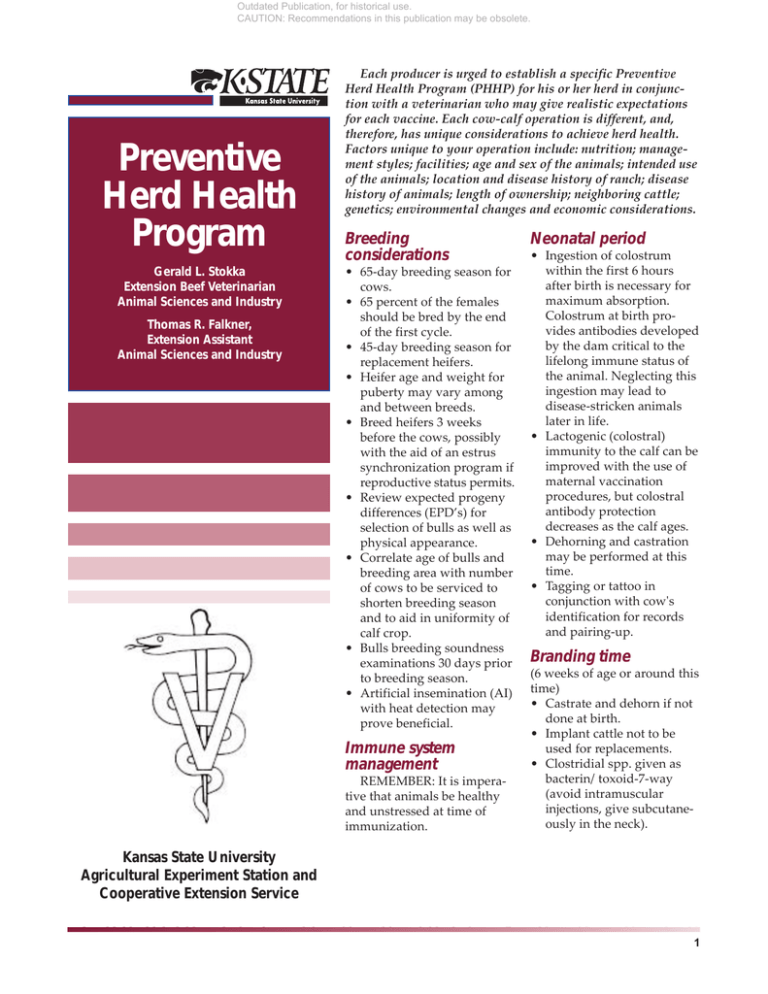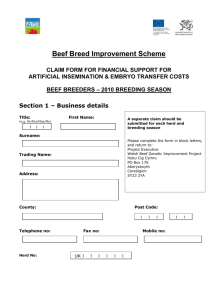
Outdated Publication, for historical use.
CAUTION: Recommendations in this publication may be obsolete.
Preventive
Herd Health
Program
Gerald L. Stokka
Extension Beef Veterinarian
Animal Sciences and Industry
Thomas R. Falkner,
Extension Assistant
Animal Sciences and Industry
Each producer is urged to establish a specific Preventive
Herd Health Program (PHHP) for his or her herd in conjunction with a veterinarian who may give realistic expectations
for each vaccine. Each cow-calf operation is different, and,
therefore, has unique considerations to achieve herd health.
Factors unique to your operation include: nutrition; management styles; facilities; age and sex of the animals; intended use
of the animals; location and disease history of ranch; disease
history of animals; length of ownership; neighboring cattle;
genetics; environmental changes and economic considerations.
Breeding
considerations
• 65-day breeding season for
cows.
• 65 percent of the females
should be bred by the end
of the first cycle.
• 45-day breeding season for
replacement heifers.
• Heifer age and weight for
puberty may vary among
and between breeds.
• Breed heifers 3 weeks
before the cows, possibly
with the aid of an estrus
synchronization program if
reproductive status permits.
• Review expected progeny
differences (EPD’s) for
selection of bulls as well as
physical appearance.
• Correlate age of bulls and
breeding area with number
of cows to be serviced to
shorten breeding season
and to aid in uniformity of
calf crop.
• Bulls breeding soundness
examinations 30 days prior
to breeding season.
• Artificial insemination (AI)
with heat detection may
prove beneficial.
Immune system
management
REMEMBER: It is imperative that animals be healthy
and unstressed at time of
immunization.
Neonatal period
• Ingestion of colostrum
within the first 6 hours
after birth is necessary for
maximum absorption.
Colostrum at birth provides antibodies developed
by the dam critical to the
lifelong immune status of
the animal. Neglecting this
ingestion may lead to
disease-stricken animals
later in life.
• Lactogenic (colostral)
immunity to the calf can be
improved with the use of
maternal vaccination
procedures, but colostral
antibody protection
decreases as the calf ages.
• Dehorning and castration
may be performed at this
time.
• Tagging or tattoo in
conjunction with cow's
identification for records
and pairing-up.
Branding time
(6 weeks of age or around this
time)
• Castrate and dehorn if not
done at birth.
• Implant cattle not to be
used for replacements.
• Clostridial spp. given as
bacterin/toxoid-7-way
(avoid intramuscular
injections, give subcutaneously in the neck).
Kansas State University
Agricultural Experiment Station and
Cooperative Extension Service
1
Outdated Publication, for historical use.
CAUTION: Recommendations in this publication may be obsolete.
• IBR-PI3-BVD-BRSV given
as a product recommended
for suckling calves (a
second injection will be
given at weaning). This
product may be used here
if there are problems with
“summer pneumonia” or if
preweaning vaccinations
cannot be given.
• Insecticides for fly control,
application too early in the
season will give poor
results.
Preweaning
This period is critical in
your vaccination program
due to increased pathogen
exposure, elevated stress
levels at weaning, and
diminished colostral (passive)
protection.
• IBR-PI3-BVD-BRSV given
as a product recommended
for suckling calves (a
second injection will be
given at weaning).
• Clostridial spp. given as
bacterin/toxoid-7-way (if
injection is given at this
time a second injection is
not needed at weaning)
(avoid intramuscular
injections, give subcutaneously in the neck).
Weaning
• IBR-PI3-BVD-BRSV given
as a modified live virus
(second injection if given at
preweaning).
• Clostridial spp. given as
bacterin/toxoid-7-way
(this injection is not needed
if doses have been given at
branding and preweaning)
(avoid intramuscular
injections, give subcutaneously in the neck).
• Parasite and grub control.
• Implant all cattle not
intended for reproduction.
• Certify calves to be sold as
“preconditioned” where
applicable.
2
4- to 12-month-old
replacement heifers
Cow and replacement
heifer vaccinations
(preferably 5 to 8 months of
age)
• Brucellosis vaccination
RB51 to all replacement
heifers.
• Follow state and federal
regulations.
• RB51 is approved for use in
Kansas.
• 30 to 60 days prior to
breeding
• Vibriosis given as a bacterin (this is the preferred
time of administration).
• Leptospirosis given as a 5way bacterin.
• IBR-PI3-BVD given as a
modified live virus.
3 weeks prior to calving
• Calf scours: E-coli +
Clostridial perfringens
type C and D given as a
bacterin/toxoid, and
Rota+Corona viruses given
as a killed vaccine if a
problem exists.
• Calves must receive
enough colostrum from
scour-vaccinated cows
within the first 24 hours to
be protected.
• Lice control (if a problem
in your herd).
Pregnancy examination
(90 days post exposure) at
convenient time such as
weaning.
• Cull open, old and unsound females.
• Parasite, lice and grub
control (lice control may
need to be repeated 21
days later or at precalving
if necessary).
• Record age, breed, number,
body condition score, and
days pregnant.
• Some vaccinations can
be given at this time
including leptospirosis and
vibriosis bacterins (if an
oil-base product is used for
vibriosis).
• Calf scours: The initial
dose of E-coli + Clostridial
perfringens type C and D
given as a bacterin/toxoid,
and Rota+Corona viruses
given as a killed vaccine if
a problem exists.
Note: It is recommended
that scour vaccinations be
given 6 and 3 weeks prior to
calving, but due to convenience, administration of the
primary dose at this time may
be acceptable. Some E-coli
products have been shown to
improve colostral immunity
for up to one year. Scours can
often be a result of environmental and management
factors and cannot be corrected with vaccination alone.
Bulls
(30 days prior to breeding)
• Vibriosis given as a
bacterin.
• Leptospirosis given as a
5-way bacterin.
• IBR-PI3-BVD given as a
modified live virus.
Nutritional considerations
• Balance diet for energy and
protein to maintain a body
score desirable for that
stage in production.
• Have forage analysis
performed on all
feedstuffs.
• In grass tetany problem
areas, high magnesium salt
should be provided 60
days before calving to the
start of breeding.
• Balance diet for vitamins
and minerals and test for
deficiencies, such as
selenium or copper.
Outdated Publication, for historical use.
CAUTION: Recommendations in this publication may be obsolete.
General management
• All incoming animals
should be vaccinated in
coordination with the
existing herd program and
possibly put in a quarantine period to help identify
diseased animals not yet
showing their true disease
state.
• Know the history of
incoming breeding stock or
test for bovine leukosis,
Johne’s and persistent BVD
infection.
• Work cattle in a.m. hours
when possible during the
summer to reduce heat
stress.
• Fly control and shade are
strongly recommended.
• Use the neck area for intramuscular and subcutaneous injections.
• Use good sanitation and,
remember, vaccines can be
inactivated by heat (sunlight), and chemical
contamination.
• Label syringes for use with
the same vaccine each time.
• Change needles often (10
to 15 animals)
Conclusion
Veterinarians are a valuable resource to aid a ranch in
record analysis and interpretation, nutrition, genetics and
management decisions.
Use a consistent, annual
vaccination program developed by your veterinarian,
specific for your area and
herd. More isn’t always better
and vaccination does not
always mean your animals
are protected, but boostering
can increase the number of
immunized animals.
3
Outdated Publication, for historical use.
CAUTION: Recommendations in this publication may be obsolete.
Brand names appearing in this publication are for identification purposes only. No endorsement is intended,
nor is criticism implied of others not mentioned.
Publications from Kansas State University are available on the World Wide Web at: http://www.oznet.ksu.edu
Contents of this publication may be freely reproduced for educational purposes. All other rights reserved. In each case, credit
Gerald L. Stokka, Preventive Herd Health Program, Kansas State University, November 1998.
Kansas State University Agricultural Experiment Station and Cooperative Extension Service
EP-50
November 1998
It is the policy of Kansas State University Agricultural Experiment Station and Cooperative Extension Service that all persons shall have equal opportunity and access to its educational programs, services, activities, and materials without regard to race, color, religion, national origin, sex, age or disability.
Kansas State University is an equal opportunity organization. Issued in furtherance of Cooperative Extension Work, Acts of May 8 and June 30, 1914, as
amended. Kansas State University, County Extension Councils, Extension Districts, and United States Department of Agriculture Cooperating, Marc A.
Johnson, Director.
4





